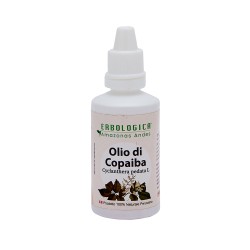
L'olio di copaiba sta guadagnando popolarità per i suoi numerosi benefici per la salute. Estratto dalla resina dell'albero di copaiba, originario della foresta amazzonica, quest'olio è stato usato per secoli dalle popolazioni indigene della regione per una serie di scopi medicinali. Negli ultimi tempi, gli scienziati hanno iniziato a scoprire i numerosi benefici potenziali dell'olio di copaiba per la salute, dalle proprietà antinfiammatorie alla capacità di ridurre il dolore e di rafforzare l'immunità. Che siate alla ricerca di un rimedio naturale per un disturbo specifico o che vogliate semplicemente migliorare la vostra salute e il vostro benessere generale, l'olio di copaiba potrebbe fare al caso vostro. Con il suo piacevole aroma di bosco e le sue proprietà curative naturali, l'olio di copaiba è l'aggiunta perfetta a qualsiasi routine di salute e benessere.
Che cos'è l'olio di Copaiba?
L'olio di copaiba è l'olio volatile estratto dalla resina dell'albero di copaiba brasiliano. L'albero cresce nelle foreste pluviali dell'America centrale e meridionale, in particolare nell'Amazzonia brasiliana, ed è indigeno di questa regione, il che lo rende unico e molto ricercato. L'albero di Copaiba è stato utilizzato per migliaia di anni per le sue numerose proprietà curative ed è uno degli alberi più utilizzati nella foresta amazzonica. Tradizionalmente, le popolazioni indigene della regione usavano l'olio per trattare una serie di disturbi, tra cui quelli gastrointestinali e respiratori. L'olio ha un colore che va dal giallo chiaro all'ambra, con un aroma dolce che ricorda il balsamo e la vaniglia. La resina che viene estratta per creare l'olio di copaiba è una sostanza appiccicosa e gialla che viene tipicamente spremuta dal tronco dell'albero.
Storia dell'olio di copaiba
La storia dell'olio di copaiba risale al XVII secolo, quando fu pubblicato il primo studio scientifico sulla specie. Alla fine del XIX secolo, le prime esportazioni di olio dal Brasile sono state effettuate utilizzando navi a vela per trasportare il prezioso carico. In questo periodo, l'albero di copaiba è stato anche protagonista di numerosi dipinti e sculture, nel tentativo di catturare il suo aspetto fantastico. Le prime ricerche scientifiche sull'olio furono condotte a metà del XIX secolo, quando il governo brasiliano iniziò a studiare l'albero e le sue numerose proprietà benefiche. Tra gli anni Trenta e gli anni Cinquanta, la maggior parte dell'olio veniva esportata nei Paesi asiatici e in Medio Oriente. Oggi l'olio è utilizzato principalmente in cosmetica e come medicina alternativa in molti paesi, tra cui gli Stati Uniti.
Benefici dell'olio di Copaiba
L'olio di copaiba ha numerose proprietà curative e viene utilizzato per trattare diversi disturbi. Ecco alcuni dei benefici più comuni dell'olio di copaiba. Proprietà antinfiammatorie - L'olio di copaiba è uno degli oli antinfiammatori naturali più potenti al mondo. È stato usato per secoli per trattare condizioni infiammatorie della pelle, come la psoriasi e l'eczema, nonché disturbi digestivi, come l'IBS e l'ulcera. Sollievo dal dolore - È stato dimostrato che l'olio di copaiba è un efficace antidolorifico, in particolare per i dolori articolari e muscolari. Può essere utilizzato per trattare un'ampia varietà di condizioni, come artrite, mal di schiena, mal di testa e altro ancora. Potenziatore delle difese immunitarie - Le proprietà antinfiammatorie dell'olio di copaiba lo rendono un eccellente potenziatore delle difese immunitarie. In quanto antinfiammatorio, può aiutare a ridurre il gonfiore, contribuendo a uccidere batteri e virus. Salute dell'apparato digerente - È stato dimostrato che l'olio di copaiba migliora la salute dell'apparato digerente e può essere usato per trattare disturbi digestivi come la sindrome dell'intestino irritabile e la colite. Può anche essere usato per trattare indigestioni, bruciori di stomaco e altri disturbi digestivi.
Effetti collaterali dell'olio di copaiba
Come ogni prodotto, l'olio di copaiba presenta alcuni effetti collaterali, anche se rari. Tra gli effetti collaterali più comuni dell'olio di copaiba vi sono nausea, bruciore di stomaco e mal di testa. L'uso dell'olio di copaiba comporta il rischio di reazioni allergiche, per cui è importante prestare attenzione a questi segnali: - prurito - Gonfiore - Respiro corto - Dolore addominale - Vomito - Diarrea
Come usare l'olio di copaiba
Esistono diversi modi per utilizzare l'olio di copaiba a beneficio della propria salute e del proprio benessere. Alcuni dei modi più comuni di usare l'olio di copaiba includono: - Applicazione topica - Il modo più comune di usare l'olio di copaiba è applicarlo topicamente sulla pelle o sui muscoli. - Uso interno - È possibile consumare l'olio di copaiba per via interna per trattare alcune condizioni, come i disturbi digestivi. - Vaporizzazione - È possibile utilizzare l'olio di copaiba anche in un diffusore o in un vaporizzatore per godere dei suoi numerosi benefici. - Inalazione - Si possono anche inalare direttamente i vapori di olio di copaiba per godere dei suoi benefici.
Dosaggio dell'olio di copaiba
Il dosaggio dell'olio di copaiba dipende dalla ragione d'uso. Per l'applicazione topica, si consiglia di utilizzare da una a cinque gocce diluite in un olio vettore, come l'olio di cocco o di jojoba. Può essere utilizzato in molti modi, come olio per massaggi, pediluvio o bagno. Può anche essere utilizzato come pomata o balsamo per la pelle. Per uso interno, si consiglia di assumere da tre a dieci gocce di olio di copaiba al giorno. Si consiglia di assumere l'olio di copaiba in una piccola quantità di acqua, poiché può essere molto potente e difficile da ingerire.
Sicurezza dell'olio di copaiba
L'olio di copaiba è stato usato in molte culture del mondo per migliaia di anni e ha dimostrato di essere sicuro ed efficace. Tuttavia, come per tutti gli altri rimedi erboristici, è meglio parlare con il proprio medico prima di iniziare un nuovo trattamento. Il medico può aiutarvi a decidere se l'olio di copaiba è adatto a voi e quale sia il dosaggio migliore. Prima di assumere l'olio di copaiba o qualsiasi altro rimedio erboristico, è importante conoscere i principi attivi di ciascun olio. Questo vi aiuterà a decidere se è adatto a voi e vi garantirà che state assumendo un olio di alta qualità. È inoltre importante notare che gli integratori a base di erbe possono impiegare più tempo per iniziare a funzionare rispetto ai prodotti farmaceutici di sintesi, quindi siate pazienti e date al vostro corpo il tempo di guarire.
Come conservare l'olio di copaiba
Come la maggior parte delle erbe e degli oli, l'olio di copaiba deve essere conservato in un luogo fresco e asciutto per prolungarne la durata. È meglio conservarlo in una bottiglia scura e in un luogo fresco e asciutto. È bene evitare di esporlo a calore, luce e umidità eccessivi per evitare che si rovini. È anche possibile acquistare una bottiglia di vetro scuro per conservare l'olio. Assicuratevi di conservare la bottiglia in un luogo fresco e asciutto per prolungarne la durata.
Ricette con olio di copaiba
L'olio di copaiba è comunemente usato per applicazioni topiche e per ingestione. Per l'applicazione topica, è meglio usare un olio vettore, come l'olio di jojoba o di cocco. Si può anche usare per fare una pomata o un balsamo per uso esterno. Per fare una pomata, si possono mescolare tre parti di olio di copaiba con una parte di cera d'api e una parte di olio di cocco. Si può anche usare per fare uno sciroppo naturale per la tosse mescolando tre parti di olio di copaiba con una parte di miele e una parte di succo di limone. Per l'ingestione, è meglio assumere l'olio di copaiba in una piccola quantità di acqua.
Ricerca sull'olio di copaiba
Sono stati condotti diversi studi sull'olio di copaiba per comprenderne i numerosi benefici e usi. Come già detto, l'olio di copaiba è ampiamente conosciuto per le sue proprietà antinfiammatorie. È stato dimostrato che riduce il gonfiore ed è un trattamento efficace per le condizioni infiammatorie della pelle. L'olio aiuta anche a migliorare la digestione, rilassando i muscoli del tratto digestivo e riducendo gli spasmi. È anche noto per contribuire a migliorare la tosse e la funzione polmonare. Uno studio ha dimostrato che l'olio di copaiba può contribuire a inibire la crescita dei batteri che causano la tosse e altre condizioni respiratorie.
Dove acquistare l'olio di copaiba
Quando si acquista un rimedio erboristico, è importante assicurarsi di ottenere un prodotto di alta qualità. Ci sono alcuni modi per capire se si tratta di un olio di alta qualità. Innanzitutto, assicuratevi che il contenitore sia scuro e opaco, in modo da proteggere l'olio dalla luce e dall'ossigeno, che possono degradare molti oli essenziali.



